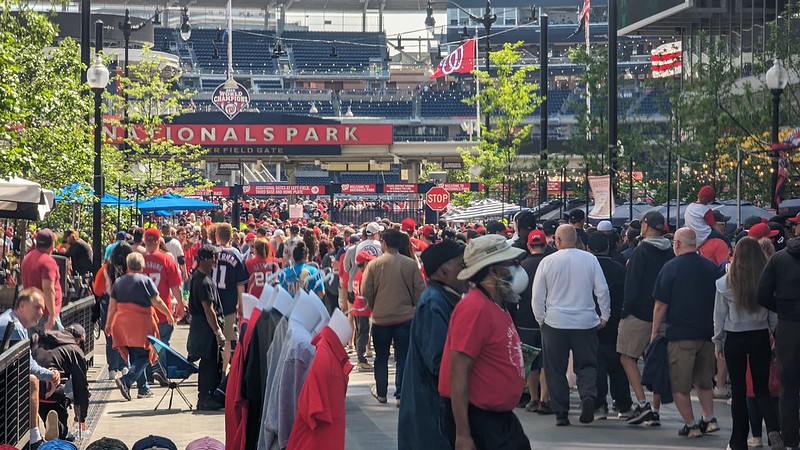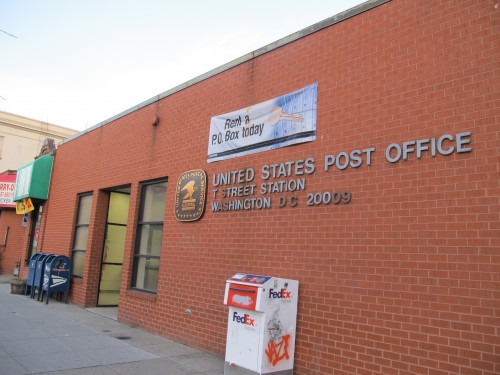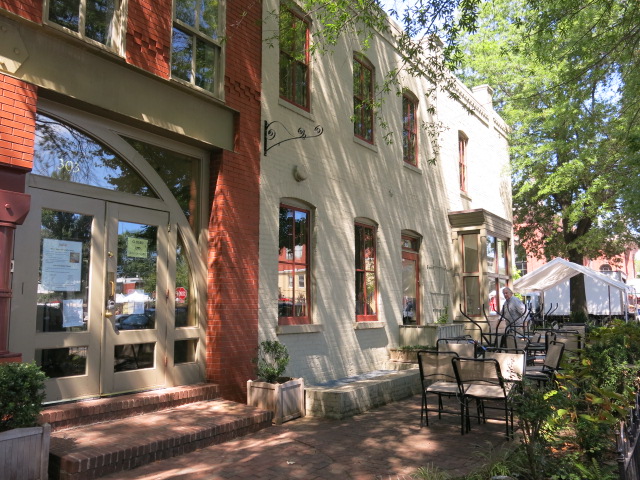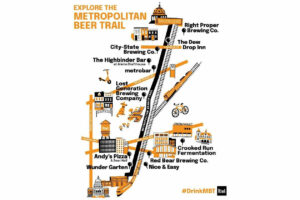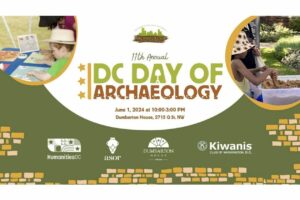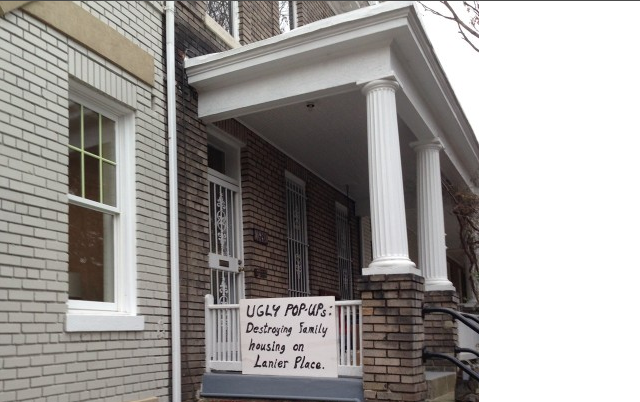
Last month we talked about this sign “Ugly Pop-Ups: Destroying Family Housing on Lanier Place.”. Following is an attempt to explain from a neighbor, Gary Tischler.
A while back, I had a talk with a neighborhood friend about popups and their implications to the Lanier Heights neighborhood, standing right across the street from one of those popups next to the day care center. He offered up the idea that maybe people should get used to the idea of change, and the popups and the targeting of the neighborhood by developers was one of those change things that might be inevitable.
That may be so, but something’s getting lost in that discussion. I saw it in the cavalier notice given by the developer reps that they had indeed targeted our neighborhood and were indeed seeking to get people to sell their houses in order to convert them to condos, and in the comments on the net that followed Paul’s signs next door to his new neighbors. In most of the comments—most of them from people who don’t live here—the attitude was one of surprise or anger that neighborhood residents—be they homeowners or renters—would object to the presence of the popups, or openly oppose the idea.
Many folks—mostly homeowners—are upset about this wholesale attempt to basically alter our neighborhood. That’s what’s getting lost in the discussions—the consequences to the neighborhood if the developers succeed.
What will happen to put it very simply is that the nature of the neighborhood will be dramatically changed to the point where we will lose most of the things, the characteristics of the neighborhood that we love.
I’m not trying to speak for other people—I’m a renter, and we’ve lived here for well over 15 years now. I found the neighborhood early on to be deceptive—I mean it looks on the surface to be kind of a bucolic place, quiet, a kind of residential, one-family housing island close to but also separate from the street scene on Columbia Road, the traffic on Calvert and the night and day bustle of 18th Street and all that entails, all of which by the way add the special urban flavor that everyone loves.
I got an immersion in Lanier Heights by walking our dog Bailey four times a day, morning, noon, evening and night, summer, fall, winter and spring for fourteen of those years. We went down and around—both blocks of Lanier, past the park, down Adams Mill Road, down to Harvard and up the hill and back and around to Ontario Place and Road. I got a real sense of where I live on those walks—the place and landscape, the nature of the population, the rhythms of daily life and time passing, and, yes, change. It was like being on some in-the-flesh party line in the open air. I found out quickly that—as a neighbor pointed out at our last meeting— the area is already quite rich in apartment units and spaces, which is to say renters like me and Carol. Some live in basements, or rent whole houses, or live in diverse spaces that are packed in all over the Heights and they constitute a sizeable and diverse part of the population.
I have to say that I met most of the people I know in the neighborhood on these walks—this is for sure a dog neighborhood, but I also found that it’s a neighborhood made unique by its diversity which we should treasure. There are people here who live in homes their families haves occupied for at least two or three generations. On these walks I’ve watched young children go from elementary school through high school, college and beyond and now there is a new influx of young families, one of which two doors down just welcomed a third child. The life cycles, like the changes in foliage and the passing of trees and pets, are a dear part of life here.
I write for publications like the Georgetowner and the Washington Diplomat, often writing about cultural matters, and so I felt right at home here, discovering over time the presence of major and minor, artists and arts leaders here like the director of the DC Jazz Festival, the director of the DC film festival, the director of Arena Stage and the Washington Ballet all living within short walking distances, along with playwrights, artists, writers and critics, poets, dancers and photographers and film makers.
The neighborhood is decidedly blue, politically lively, and while liberal doesn’t lack for heated differences of opinion on just about everything. Folks here are old and young, and babies and aging, white and black and Hispanic and gay and straight and every which other thing you can be. We have crime—I experienced a near mugging a few years back—but we have, if not a neighborhood watch, neighborhood watchers nonetheless. We have a history here, and we have people that care—I can’t imagine Joseph’s House anywhere except where it is, a unique and special part of our neighborhood. So is the fire house and Adams Inn, and the Ontario. Right after 9/11 there was a fire next door and I saw how neighbors pulled together to help out. It’s the kind of thing that happens organically and naturally and often.
It’s the kind of neighborhood where people know each other even if they don’t always socialize en masse or in groups. Maybe, given the situation, we should do more of that, or at least communicate and use the tech tools at hand as we are now in a time of crisis. But we know who we are, and why we all live here. During my walks I saw—through community efforts by individual and groups—the barren, often ragged park evolve into a the great children’s playground that we have, the wide and green athletic field and the emergence of a dog park when there was no such thing in this city.
I think we all value what we have here—we perhaps don’t celebrate it often enough, although these things always become clear to us on Halloween, or at the party for the 100th anniversary of the fire house, or when we talk to an Aussie or a family from France staying at the Adams House, or when we lose, as everyone does, good neighbors and friends like Mickey Collins and his mother, who were representative of a whole swath of African American history that was a part of this place. We are not huddled in our houses or apartments here—we share the miseries of power outages, Snowmageddon, city services when they falter and so on.
We stand to lose a lot of that if popups become the new normal here. Imagine how the pop up people look at Joseph’s house—how many condos can that hold? We will quadruple the foot traffic, have less parking places, more need for services, more people, and the economic effect—I’m no expert here—will hit both homeowners and renters with increased prices and rents. It’s not that we shouldn’t welcome new people, because it happens all the time. It’s not even that the popups tend to be eyesores although God knows they are. It’s that there’s an effort—a consequence if you will—to make this neighborhood homogonous, to destroy diversity of people, ideas, landscape and geography and function right out of the place where you live. That’s the real danger—the danger of losing the qualities that make Lanier Heights special to the people that live here now.
Gary Tischler
Recent Stories
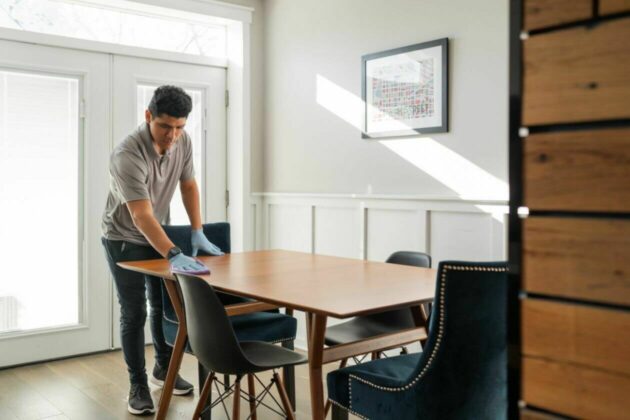
For many remote workers, a messy home is distracting.
You’re getting pulled into meetings, and your unread emails keep ticking up. But you can’t focus because pet hair tumbleweeds keep floating across the floor, your desk has a fine layer of dust and you keep your video off in meetings so no one sees the chaos behind you.
It’s no secret a dirty home is distracting and even adds stress to your life. And who has the energy to clean after work? That’s why it’s smart to enlist the help of professionals, like Well-Paid Maids.

Unlock Peace of Mind for Your Family! Join our FREE Estate Planning Webinar for Parents.
🗓️ Date: April 25, 2024
🕗 Time: 8:00 p.m.
Metropolitan Beer Trail Passport
The Metropolitan Beer Trail free passport links 11 of Washington, DC’s most popular local craft breweries and bars. Starting on April 27 – December 31, 2024, Metropolitan Beer Trail passport holders will earn 100 points when checking in at the
DC Day of Archaeology Festival
The annual DC Day of Archaeology Festival gathers archaeologists from Washington, DC, Maryland, and Virginia together to talk about our local history and heritage. Talk to archaeologists in person and learn more about archaeological science and the past of our


